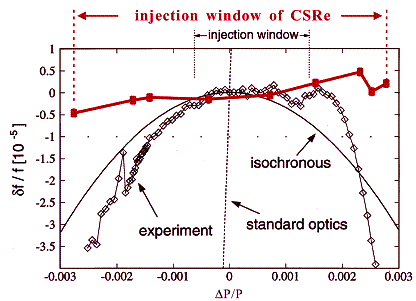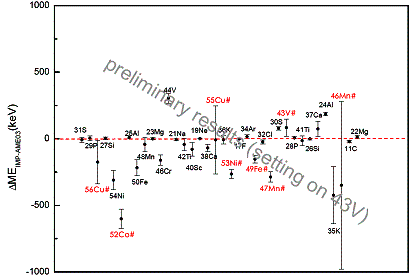The HIRFL-CSR complex was operated as Isochronous Mass Spectrometry (IMS) for mass measurements in Institute of Modern Physics (IMP), CAS recently. The 58Ni beam was accumulated in the main ring of CSR(CSRm) and then accelerated to an energy of ~463 MeV/u. The high-energy beam was fast extracted from CSRm and focused upon a ~15 mm thick beryllium production target. The exotic nuclei of interest were produced by projectile fragmentation of 58Ni. After in-flight separation of the fragments in RIBLL2, the cocktail beam of exotic nuclei was injected into the experimental ring of CSR(CSRe) for mass measurements.
In order to obtain high precision mass data, the power system of CSRe was upgraded in this experiment and the stability of magnetic field has reached to about 10-5. The setting of IMS was optimized using sextupole field during the present experiment, and a frequency variation of about δf/f~10-6 was obtained in the acceptance of δP/P ~0.5%, (see Fig.1). Masses of several nuclides near proton drop-line were determined with a precision of δm/m~10-7 for the first time, a preliminary result is shown in Fig.2. The data from the measurements are under analysis.

Fig.1. Revolution frequency as a function of the δP/P. Experimental data indicated by red color are from CSRe which are compared with the result of GSI (black).(Image by Institute of Modern Physics)

Fig.2. The preliminary results from this experiment. The nuclides indicated by red color are determined for the first time.(Image by Institute of Modern Physics)

